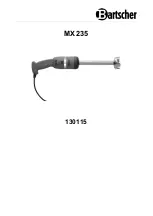
Troubleshooting
Problem
Possible Cause
Solution
No sound, or very low sound
signal from condenser
microphones
No phantom power
Connect or activate phantom
power supply
Volume set too low
Increase incoming volume and
gain on your mixer, interface or
other sound processing device
Microphone positioned too far
away
Place the microphone closer to the
sound source
Loud high frequencies coming
from the speakers
Microphone positioned too close to
the speakers, which causes
feedback
Immediately close the channel
fader or mute the channel on your
mixer or interface. Then move the
microphone further away from the
speakers, or change the position
to prevent the microphone to be
aimed directly at the speakers.
Interruptance of connected
sources
Loose cable or broken cable
Check if the cable is plugged into
the microphone correctly. If that
does not solve the problem, try to
change the cable.
No sound coming from the mixer
Channel fader closed
Slightly increase the channel fader
to the '0' position
Gain set too low
Increase gain until the Peak LED
starts flickering slightly
Master fader closed
Slightly increase the master fader
to the '0' position
No sound on monitor (AUX)
channel
AUX potentiometer on channel
closed
Increase the AUX level on each
active channel
AUX master level potentiometer
closed
Increase the AUX level on the AUX
master level
AUX connected wrong
Check if the monitor output signal
is connected to the AUX output
correctly.
No signal source
Check if the connected signal
sources are sending their signal
correctly into the mixer.
Distorted sound coming from the
headphones or master output
Gain set too high, clipping inputs
Decrease the gain from the
distorting channel to a moderate
level
Channel fader set too high,
clipping channel
Decrease the channel fader
volume
Any information and illustrations shown in this user manual are subject to change without further notice.
User manual version: 1.0
Creation date + author initials: 27-08-2013 RV Revision date + author initials: 20-02-2014 RV






























